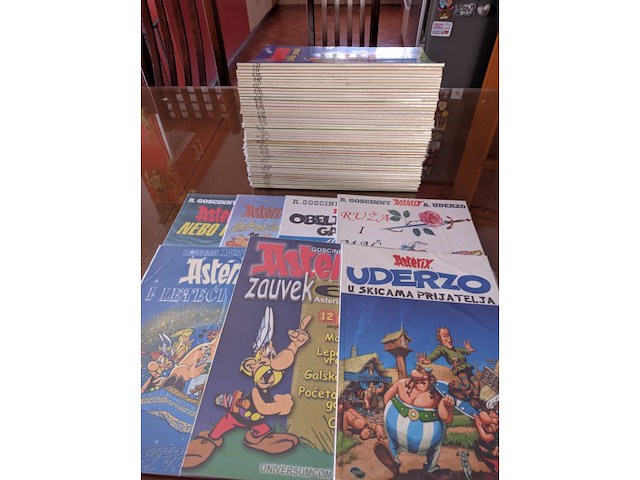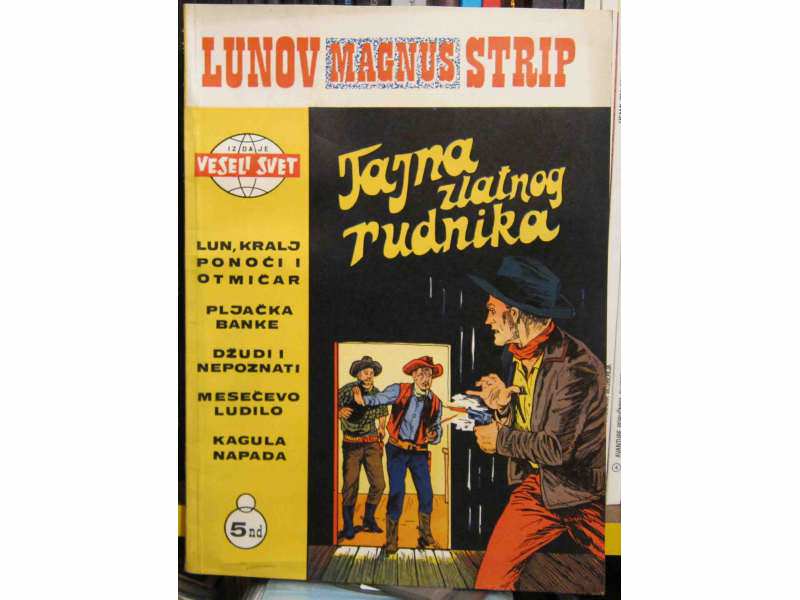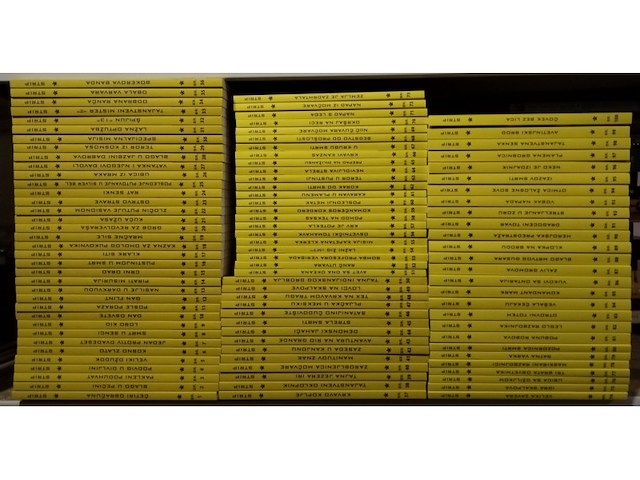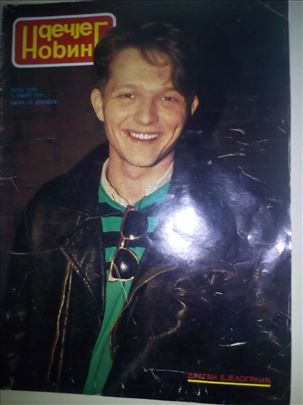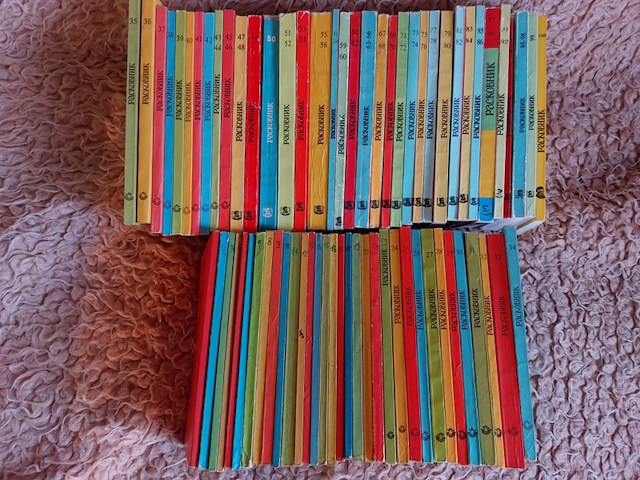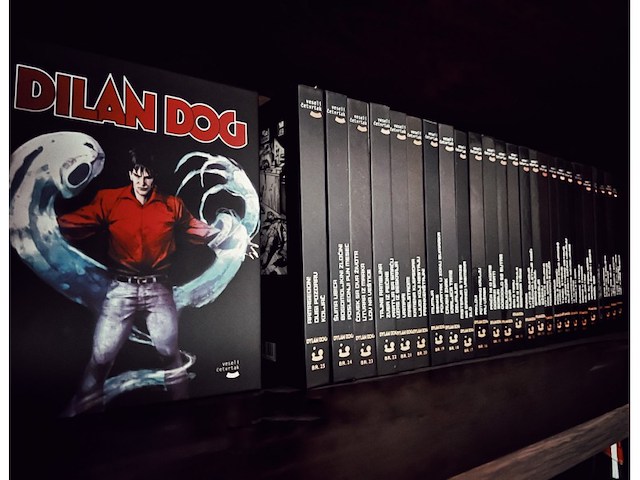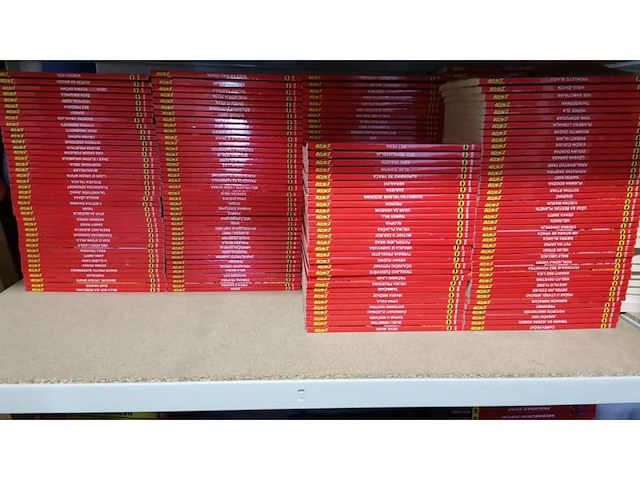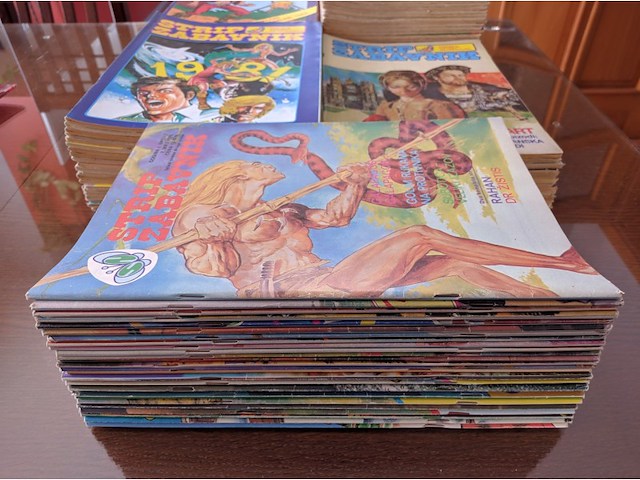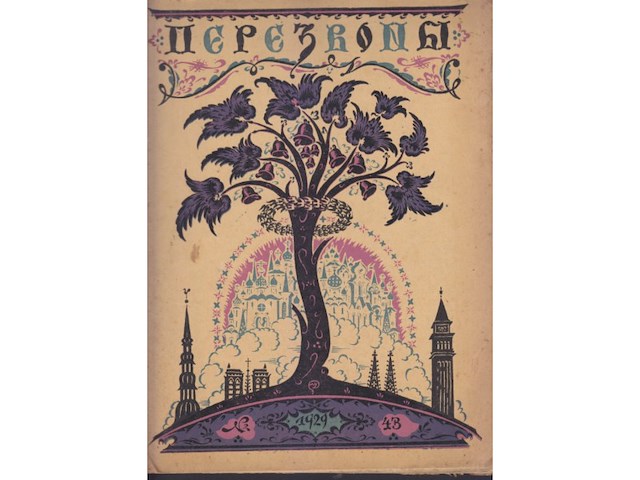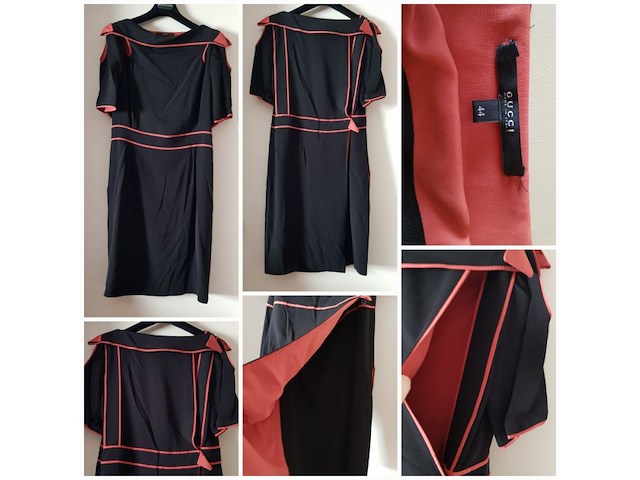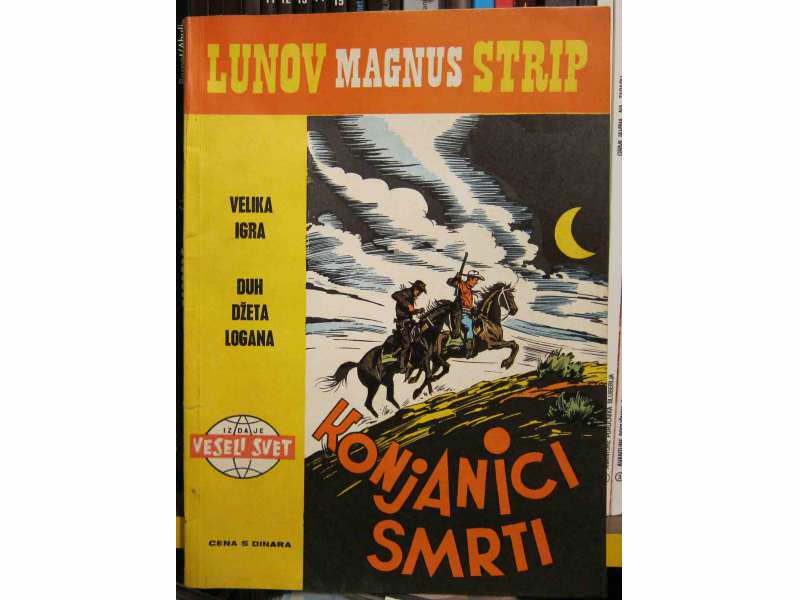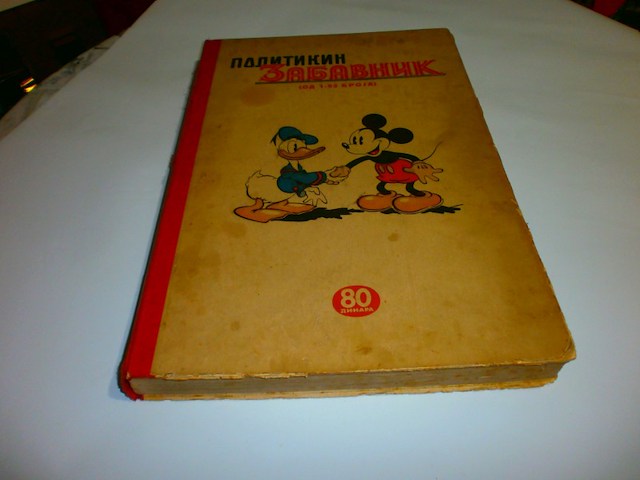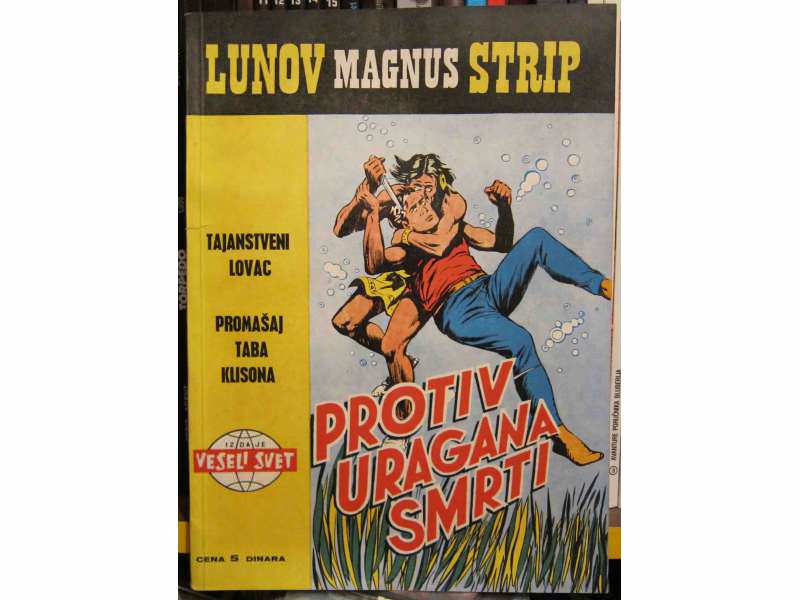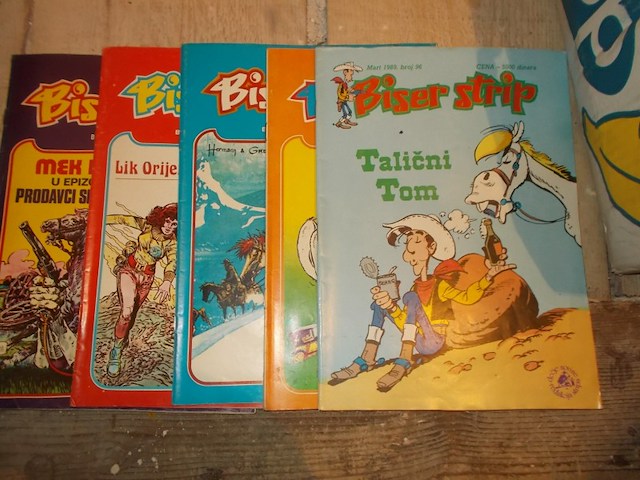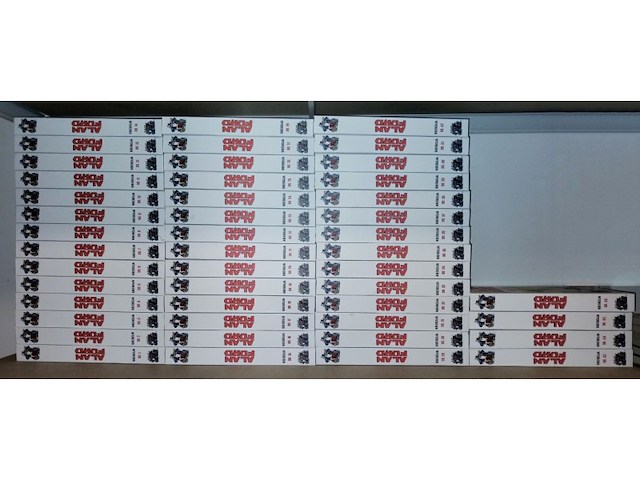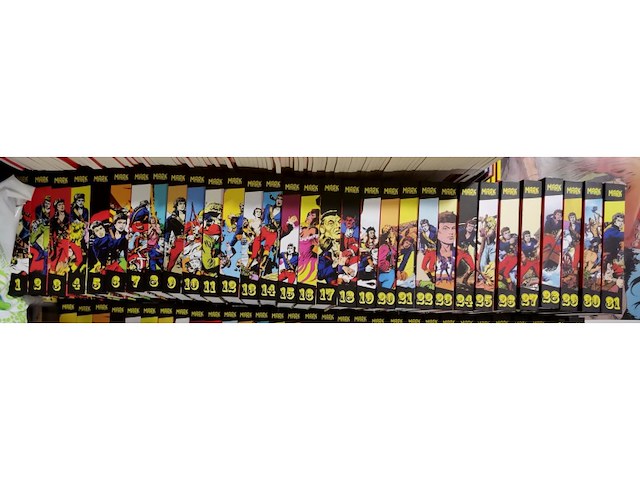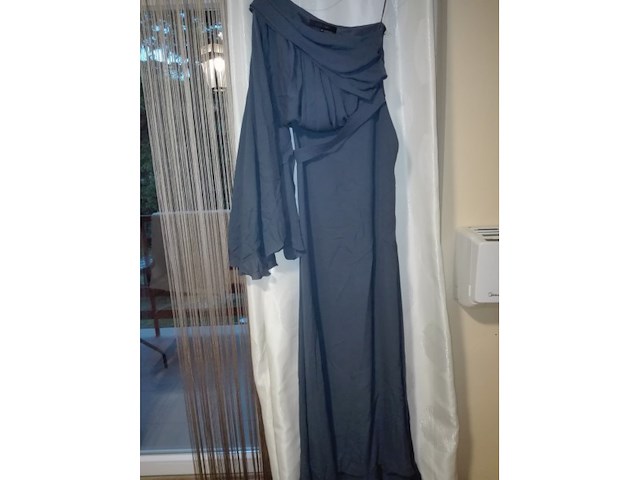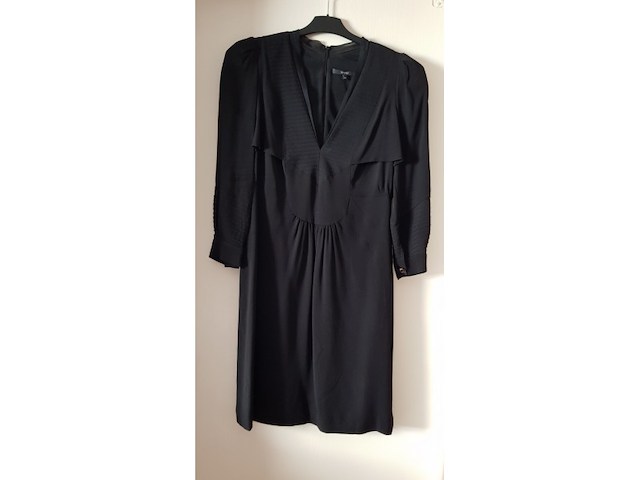Pratite promene cene putem maila
- Da bi dobijali obaveštenja o promeni cene potrebno je da kliknete Prati oglas dugme koje se nalazi na dnu svakog oglasa i unesete Vašu mail adresu.
1-25 od 53 rezultata
Režim promene aktivan!
Upravo ste u režimu promene sačuvane pretrage za frazu .
Možete da promenite frazu ili filtere i sačuvate trenutno stanje
Aktivni filteri
OCENA ZA 4 BR.28. ZA 4+ BR. 4,5,6,7,24,27,29,31,43. ZA 4+,5- BR.1,3,14,16,17,30,32. ZA 5- BR. 2,10,13,18,22,37,46. ZA 5-,5 BR.8,9,12,19,20,23,25,26,38. ZA 5 BR. 11,15,21,42. ZA 5,5+ BR.36. ZA 5+ BR. 33,34,35,39,40,41,44,45,47,48. BROJ 28 CRTANO PO POSLEDNJOJ STRANI SA POPISOM IZDAVAČA 10X5 cm + JOŠ JEDAN BROJ 28, BEZ KORICA SAMO STRANICE, OCENA ZA STRANICE 5-. BROJEVI 5,6,7 BLAGO OŠTEĆEN HRBAT NA SREDINI DODATAK KOMPLETU UDERCO U SKICAMA PRIJATELJA - GLANC 12 PODVIGA - CRNO BELI - GLANC LETEĆI ĆILIM - CRNO BELI - GLANC RUŽA I MAČ - CRNO BELI - GLANC OBELIKSOVA GALIJA - CRNO BELI - GLANC LATRAVIATA - CRNO BELI - 4+ NEBO KOJE PADA - GLANC ODREĐENI BROJ STRIPOVA JE U MOJIM ZAŠTITNIM KESICAMA.
Zlatna serija 1-100, remasterizovani, reprintovani u originalnoj dimenziji. Dati primeri kako to izgleda u odnosu na original. ocuvano spisak epizoda 1968 1. Teks Viler: Četiri obračuna 2. Žan Kanada: Blago u pećini 3. Deni i Sam: Pakleni poduhvat 4. Red Bak: Podvig u divljini 5. Veliki Džudok: Veliki Džudok 6. Red Bak: Kobno zlato 7. Teks Viler: Jedan protiv dvadeset 8. Teks Viler: Smrt u senci 9. Lobo Kid: Lobo kid 10. Lari: Dan osvete 11. Alan: Posle poraza 12. Gan Flint: Gan Flint 13. Zagor: Nasilje u Darkvudu 14. Tim i Dasti: Pirati Misurija 15. Deni i Sam: Crni orao 16. Deni i Sam: Pustinjom u smrt 17. Zagor: Klark Siti 1969 18. Teks Viler: Kazna za oholog pukovnika 19. Teks Viler: Mračne sile 20. Agent Pigi: Grob za revolveraša 21. Zagor: Kuća užasa 22. Rik Random: Zločin putuje vasionom 23. Rori Mekdaf: Ostrvo strave 24. Brad Logan: Rat senki 25. Teks Viler: Poslednje putovanje u Silver Bel 26. Zagor: Ubica iz mraka 27. Tim i Dasti: Vatanka i njegovi đavoli 28. Tim i Dasti: Blago u jazbini dabrova 29. Rik Rendom: Teror iz kosmosa 30. Zagor: Specijalna misija 31. Bak Džon: Lažna optužba 32. David Dafti: Špijun `13` 33. Teks Viler: Tajanstveni Mister `Pi` 34. Teks Viler: Odbrana ranča 35. Teks Viler: Obala varvara 36. Teks Viler: Bokerova banda 37. Teks Viler: Krvavo koplje 38. Mali rendžer: Tajanstveni oklopnik 39. Zagor: Tajna jezera Iri 40. Lindi Manon: Zarobljenica močvare 41. Mali rendžer: Manituov znak 42. Teks Viler: Zaseda u kanjonu 1970 43. Teks Viler: Avantura na Rio Grande 44. Narednik Jork: Demonski jahači 45. Teks Viler: Strela smrti 46. Teks Viler: Satanijino čudovište 47. Teks Ton: Pljačka u Meksiku 48. Teks Viler: Teks na krvavom tragu 49. Red Bak: Lovci na skalpove 50. Mali rendžer: Tajna indijanskog groblja 51. Džet Logan: Avet sa dna okeana 52. Mali rendžer: Ranč utvara 53. Zagor: Bomba profesora Veribada 54. Mali rendžer: Lažni žig `M7` 55. Priče sa Divljeg Zapada: Misija kapetana Klerka 56. Priče sa Divljeg Zapada: Osvetnički tomahavk 57. Priče sa Divljeg Zapada: Krv je potekla 58. Priče sa Divljeg Zapada: Pohod na Teksas 59. Priče sa Divljeg Zapada: Komančeros Kordero 60. Priče sa Divljeg Zapada: Poslednji metak 61. Priče sa Divljeg Zapada: Karavan u plamenu 62. Priče sa Divljeg Zapada: Korak do smrti 63. Priče sa Divljeg Zapada: Teror u pustinji 64. Priče sa Divljeg Zapada: Nevidljiva strela 65. Priče sa Divljeg Zapada: Prepad na diližansu 66. Priče sa Divljeg Zapada: Krvavi Kanzas 1971 67. Priče sa Divljeg Zapada: U krugu smrti 68. Priče sa Divljeg Zapada: Bekstvo od prošlosti 69. Priče sa Divljeg Zapada: Noć čuvara lukova 70. Priče sa Divljeg Zapada: Okršaj na reci 71. Priče sa Divljeg Zapada: Napad s leđa 72. Priče sa Divljeg Zapada: Bubnjevi iz močvare 73. Priče sa Divljeg Zapada Zemlja je zadrhtala 74. Priče sa Divljeg Zapada Velika zavera 75. Dejvi Kroket: Igra skalpova 76. Dejvi Kroket: Ubica sa ožiljkom 77. Bill Brothers: Tri brata osvetnika 78. Bill Brothers: Maskirani razbojnici 79. Bill Brothers: Ratna varka 80. Mali Rendžer: Pozornica smrti 81. Venson Bajon: Pobuna robova 82. Džuma Kid: Leglo razbojnika 83. Zagor: Otrovni totem 84. Mali Rendžer: Vešala čekaju 85. Komandant Mark: Komandant Mark: 86. Komandant Mark: Vukovi sa Ontarija 87. Komandant Mark: Zaliv gromova 88. Komandant Mark: Blago mrtvog gusara 89. Komandant Mark: Klopka na brodu 90. Komandant Mark: Herojska predstraža 1972 91. Komandant Mark: Dragoceni tovar 92. Komandant Mark: Streljanje u zoru 93. Komandant Mark: Vobak napada 94. Komandant Mark: Otmica žalosne sove 95. Komandant Mark: Izazov smrti 96. Komandant Mark: Neko je izdajnik 97. Komandant Mark: Plamena grobnica 98. Komandant Mark: Tajanstvena senka 99. Komandant Mark: Avetinjski brod 100. Komandant Mark: Čovek bez lica
-
Kolekcionarstvo i umetnost chevron_right Knjige
Dečje novine - Dragan Bjelogrlic - Nindza Kornjace Veoma retko i raritetno izdanje iz 1991. godine. Teme: Na tragu prirode. Siroko Srce. Priroda i drustvo. Kalendar istorijskih dogadjaja. Odabrane price, pesme... Grigor Vitez. Mitska bica nasih predaka. Mitovi i legende - Antlantida, el Dorado. Kultura ponasanja. Sa nasim reporterom po Svetu. Kompjuterski leksikon. Pronalasci za civilizaciju. Strip pokretna konjusnica. Spomenak. Stubac Zaljubac. Skoloskop. Astrologija. Sport - Robert Prosinecki natrazeniji fudbaler evrope, nasi najbolji u skoku u vis. Saobracaj. Eureka: Smeh divljeg Zapada. Misaone igre: Ukrstene reci, osmosmerka, skriveni crtez, lavirint, rebus uoci razliku, morske ribe u osmosmerci...
Informacije o Proizvodu Veličina: 40 Grad: Beograd Materijali: saten Tagovi: vencanica Stanje predmeta: odlično Boja: bela Vencanica je nosena samo jednom. Nova kupljrnja u Turskoj . Moguca je proba u Beogradu. Venčanica se pertla pozadi tako da moze lako da se koriguje.
-
Kolekcionarstvo i umetnost chevron_right Knjige
Tajne japanske astrologije KIGAKU Znati kako upravljati sopstvenim telom i zdravljem, znati kako urediti odnose sa ljudima, i znati kako usmeriti sreću i sudbinu, tri su umeća koja će biti sudbonosna za vreme koje je pred nama. Rak, nova bolest sida, stres, duševna nestabilnost, u nastupajućem vremenu najviše će pretiti našem telu i duhu. Da izbegnemo bolesti i sačuvamo stabilnost duha, poslužiće nam znanje o devet zvezda – kjusei, koji se jednostavno naziva KIGAKU. Ljudi ne mogu ni da žive ni da rade sami. U svim sredinama u kojima provode vreme sa nekim, harmonija je veoma važna. Nebeska energija, primljena rođenjem, prati nas kroz čitav život i u svim njegovim vidovima. Energija drugihje takođe uvek sa njima, tako da, kada se susrećemo sa ljudima, potiranje te energije, njeno pojačavanje ili jednostavno mimoilaženje, određuje godina i vreme kad smo se rodili. Da li smo izabrali dobre životne saputnike, dobre saradnike, da li se družimo sa pravim ljudima i kakve su nam zajedničke sudbine predodređene, može nam otkriti jedna od nauka „devet zvezda“ – KIGAKU. Da pronađete najboljeg partnera za ljubav, brak, druženje, putovanje, zajednički rad, zabavu, pomaže vam drevna japanska knjiga KIGAKU. 1100 Din
Hronoloska kolekcija, od prvog broja pa do broja 400 očuvano Zagor 001 Suma zamki Zagor 002 Uzas Zagor 003 Recno zlato Zagor 004 Zuti gavran Zagor 005 Dvojnici Zagor 006 Slomljeno koplje Zagor 007 Narod iz močvare Zagor 008 Zagorova osveta Zagor 009 Zakon indijanaca Zagor 010 Ples sekire Zagor 011 Ostrvo straha Zagor 012 Na tragu titana Zagor 013 Zelena provalija Zagor 014 Trgovci robljem Zagor 015 Ajron Men Zagor 016 Goospodari vatre Zagor 017 Smrtna kazna Zagor 018 Senke Zagor 019 Indijanska teritorija Zagor 020 Pakao zivih Zagor 021 Zagorov gnev Zagor 022 Lesinar Zagor 023 Duga noc Zagor 024 Morske hijene Zagor 025 Trag Zagor 026 Neprijatelj u senci Zagor 027 Zagor napada Zagor 028 Klark Siti Zagor 029 Lovci na ljude Zagor 030 Ljudski plen Zagor 031 Rat Zagor 032 Begunac Zagor 033 Kuca uzasa Zagor 034 Sumski sakali Zagor 035 Ucenjivaci Zagor 036 Sam protiv svih Zagor 037 Poslednji izazov Zagor 038 Zarobljenik Zagor 039 Mrznja Zagor 040 Duh proslosti Zagor 041 Pobeda Zagor 042 Cudoviste iz lagune Zagor 043 Seminole Zagor 044 Osvetnici Zagor 045 Satko Zagor 046 Zandar pik Zagor 047 Krvava staza Zagor 048 Zveri Zagor 049 Vukodlak Zagor 050 Skriveni grad Zagor 051 Begunci Zagor 052 Smrt na reci Zagor 053 Crna boginja Zagor 054 Bozic kalibra 45 Zagor 055 Zagor prica Zagor 056 Gospodar Darkvuda Zagor 057 Dzek mohikanac Zagor 058 Samoubilacki zadatak Zagor 059 Tajna sluzba Zagor 060 Streljanje Zagor 061 Crveni strelac Zagor 062 Smrtonosna strela Zagor 063 Izazov nepoznatog Zagor 064 Fakir Ramat Zagor 065 Gusarski brod Zagor 066 Medzik bet Zagor 067 Kralj orlova Zagor 068 Duh Zagor 069 Sestorica sa plave zvezde Zagor 070 -Plamenovi u noci Zagor 071 Cvet koji ubija Zagor 072 Zemlja bez zakona Zagor 073 Cudni gospodin smit Zagor 074 Limena zvezda Zagor 075 Alahova ruka Zagor 076 Crni seik Zagor 077 Molok Zagor 078 Snezni Sokolovi Zagor 079 Eskim Zagor 080 Prica o Zagoru Zagor 081 Pobuna trapera Zagor 082 Gvozdeni voz Zagor 083 Bela maska Zagor 084 Indijanski cirkus Zagor 085 Teskoba Zagor 086 Zagor protiv vampira Zagor 087 Tragicna zora Zagor 088 Americka odiseja Zagor 089 Paklena magla Zagor 090 Zagor odmetnik Zagor 091 Sloboda ili smrt Zagor 092 Do posljednje kapi krvi Zagor 093 Vudu Zagor 094 Noc carobnjaka Zagor 095 Zombiji Zagor 096 Hammad Egipcanin Zagor 097 Ocean Zagor 098 Crna zastava Zagor 099 Kapetan Zmija Zagor 100 Moj prijatelj Jim Gitara Zagor 101 Tragedija na karnevalu Zagor 102 Pobunjenici iz Louisiane Zagor 103 Urotnici Zagor 104 Dobar i los Zagor 105 Divlje planine Zagor 106 Spaljena zemlja Zagor 107 Povratak u Darkwood Zagor 108 Odbrojavanje Zagor 109 Prijetnja iz zraka Zagor 110 Trojica u opasnosti Zagor 111 Tajanstvene vode Zagor 112 Prokleta koliba Zagor 113 Poruke smrti Zagor 114 Ocajnicko putovanje Zagor 115 Crveni pijesak Zagor 116 Posljednja zrtva Zagor 117 Dolaze samuraji Zagor 118 Sjekira i sablja Zagor 119 Bijes ratnika Osaga Zagor 120 Billy Boy iza resetaka Zagor 121 Dan pravde Zagor 122 Zbogom, crveni brate Zagor 123 Pustolov Zagor 124 Zagor protiv Supermikea Zagor 125 Sedma runda Zagor 126 U sluzbi cara Zagor 127 Jama smrti Zagor 128 Kraj tiranina Zagor 129 Ubilacko ludilo Zagor 130 Duh iz Stone-Hilla Zagor 131 Carobnjak Kandrax Zagor 132 Sesta noc mjeseca Zagor 133 Sandy River Zagor 134 Kazneni odred Zagor 135 Stup za mucenje Zagor 136 Tigar Zagor 137 Vjestica Dharma Zagor 138 Magija Uzasa Zagor 139 Tajanstveni jahac Zagor 140 Plavokosa opasnost Zagor 141 Dvojica talaca Zagor 142 Ljudozderi iz Green Spota Zagor 143 Masai Killer Zagor 144 Gospodar zmija Zagor 145 Sake i zlato grumenje Zagor 146 Kad Zagor ppobjesni Zagor 147 Zelena prijetnja Zagor 148 Vatreno krstenje Zagor 149 Crveni ratnik Zagor 150 Znak hrabrosti Zagor 151 Utvrda Smirnoffa Zagor 152 Zadatak Obavljen Zagor 153 Duhovi Zagor 154 Bez predaha Zagor 155 Tropical Corp Zagor 156 Zuta groznica Zagor 157 Sovina krcma Zagor 158 Zlocin na brodu Zagor 159 Kineski idol Zagor 160 Carev Pecat Zagor 161 Tiranin sa jezera Sosich Zagor 162 Junacki Vod Zagor 163 Potopite Destroyer Zagor 164 Preokret Zagor 165 Konacni obracun Zagor 166 Pozar u utvrdi jericho Zagor 167 Nevidljivi Covjek Zagor 168 Nestalo pleme Zagor 169 Krilati osvetnik Zagor 170 Banditi bez lica Zagor 171 Putovanje bez povratka Zagor 172 Posljednji viking Zagor 173 Male ubojice Zagor 174 Veliki strah Zagor 175 Put na _Zapad Zagor 176 Sierra Blanca Zagor 177 Jim Gitara se vraca Zagor 178 Crvena orhideja Zagor 179 Helingen Zagor 180 Zraka smrti Zagor 181 Uzas sa sestog planeta Zagor 182 Vjecna magija Zagor 183 Izazivac Zagor 184 Gotova stvar Zagor 185 Planina_Bogova Zagor 186 Narod noci Zagor 187 Povratak vampira Zagor 188 Kraljevstvo tame Zagor 189 Uzasna zaraza Zagor 190 Dolina duhova Zagor 191 Vjecni covjek Zagor 192 Skidaci glava Zagor 193 Besmrtni Zagor Zagor 194 Plamena lubanja Zagor 195 Crni gospodar Zagor 196 Horda zla Zagor 197 Thunderman Zagor 198 Vuk samotnjak Zagor 199 Krug života Zagor 200 Prokleto blago Zagor 201 Devil mask Zagor 202 Bijeli odmetnik Zagor 203 Napad u mocvari Zagor 204 Cudnovati zlocinac Zagor 205 Sotonski napitak Zagor 206 Kamena kula Zagor 207 Maska mržnje Zagor 208 Tamnicari Zagor 209 Velika prijevara Zagor 210 Pećinski ljudi Zagor 211 Troglavo cudoviste Zagor 212 Očajnički pothvat Zagor 213 Krvavi rudnik Zagor 214 Tvrdjava prokletih Zagor 215 Ubojica iz Darkwooda Zagor 216 Potopljeni grad Zagor 217 Mutant u zasjedi Zagor 218 Velika pljačka Zagor 219 Klopka Zagor 220 Timber Bill Zagor 221 Udar za udarom Zagor 222 Prorok Zagor 223 Dvoboj na Velikim Jezerima Zagor 224 Zasjeda Zagor 225 Neranjivi Zagor 226- Supermike se vraća Zagor 227 Vlak duhova Zagor 228 Crni Vragovi Zagor 229 Lice neprijatelja Zagor 230- Pet pera Zagor 231 Stravicno putovanje Zagor 232 Brodolom na Misuriju Zagor 233 Bijeg u preriju Zagor 234 Isjeceno lice Zagor 235 Žig sramote Zagor 236 Pećina s mumijama Zagor 237 Zagor protiv Zagora Zagor 238 Zasjeda u zoru Zagor 239 Smrt u zraku Zagor 240- Sabotaža Zagor 241 Brod izgubljenih ljudi Zagor 242 Močvara strave Zagor 243 Prokleta zemlja Zagor 244 Ratnici pokopanog grada Zagor 245 Karavane u borbi Zagor 246 utvrda izdaje Zagor 247 Kobna zasjeda Zagor 248 Plavi vojnici Zagor 249 Opsjednuti Zagor 250 Kandraxova osveta Zagor 251 Napad na dvorac Zagor 252 Genij zlocina Zagor 253 Pobuna Mohavka Zagor 254 Lovci na skalpove Zagor 255 Vatrena voda Zagor 256 Ratna staza Zagor 257 Trgovci oruzjem Zagor 258 Tajna jedne karte Zagor 259 Covjek sjena Zagor 260 Neumoljivi Zagor Zagor 261 Dani strave Zagor 262 Gospodar vremena Zagor 263 Ubojica od kamena Zagor 264 Noc potopa Zagor 265 Žrtveni hram Zagor 266 Grabežljivci iz Vražje Doline Zagor 267 Vladar ponora Zagor 268 Bijeli pakao Zagor 269 Osveta Crne ruke Zagor 270 Zmajeva usta Zagor 271 Glas koji ubija Zagor 272 Jeti Zagor 273 Sedam moci Zagor 274 Bounty Killer Zagor 275 Nocne more Zagor 276 Demon ludila Zagor 277 Budjenje Titana Zagor 278 Povratak Hellingena Zagor 279 Na granici stvarnosti Zagor 280 Kraj svijeta Zagor 281 Blago iz grada duhova Zagor 282 Nemilosrdni Jess Zagor 283 Tonkino prokletstvo Zagor 284 Starac s brda Zagor 285 Ultimatum Zagor 286. Indijanski rat Zagor 287 Odabrana zrtva Zagor 288 Napustena misija Zagor 289 Sveti brijeg Zagor 290 Sjene Zagor 291 Stotinu lica straha Zagor 292 Bica iz mrtve vode Zagor 293 Utvrda cudovista Zagor 294 Ljudi pume Zagor 295 Pecina vjetra Zagor 296 Staza osvete Zagor 297 Izmedju dvije vatre Zagor 298 Pleme u opasnosti Zagor 299 Crveni strazari Zagor 300 Utrka sa sedam strelica Zagor 301 Glava mrtvaca Zagor 302 Bijeg iz rezervata Zagor 303 Divlje staze Zagor 304 Ljudi Divljega Zapada Zagor 305 Maglovita rijeka Zagor 306 Veliki mrak Zagor 307 Zagor u škripcu Zagor 308 Zlokobno predskazanje Zagor 309 Potopljena šuma Zagor 310 Diablarove vradžbine Zagor 311 Smrtna opasnost Zagor 312 Mutacija strave Zagor 313 Nemani iz Crne rijeke Zagor 314 Bespoštedna bitka Zagor 315 Dva ortaka Zagor 316 Lov na vuka Zagor 317 Rijecni Duh Zagor 318 Kapetanova tajna Zagor 319 Tajanstveni Samostan Zagor 320 Zivi pokopani Zagor 321 Sveto drvo Zagor 322 Priznanje Zagor 323 Dan otkupa Zagor 324 Indijanska krv Zagor 325 Zatrovani tomahavk Zagor 326 Prokleto zlato Zagor 327 Indijansko groblje Zagor 328 Omca Zagor 329 Tragedija u Silver townu Zagor 330 Izdajnik Zagor 331 Ljudi i zvijeri Zagor 332 Sramotan sporazum Zagor 333 Zeljezni narednik Zagor 334 Noc krvoprolica Zagor 335 Kradljivac sjena Zagor 336 Covjek s puskom Zagor 337 Bijela srdzba Zagor 338 Smrt u ledu Zagor 339 Sotonski izum Zagor 340 Nemoguca dimenzija Zagor 341 Bijela indijanka Zagor 342 Krivotvoritelji Zagor 343 Opsjednuti Zagor 344 Alhemičareva Senka Zagor 345 Nestali Istraživač Zagor 346 Severozapadni Prolaz Zagor 347 Arkticka Sfinga Zagor 348 Pobunjenici Zagor 349 Aljaska Zagor 350 Ratnici gromovnika Zagor 351- Zmajevi gusari Zagor 352 Otok gubavaca Zagor 353 Razbojnici Zagor 354 Okrsaj u Los Angelesu Zagor 355 Konkvistadori Zagor 356 Sedam gradova Cibole Zagor 357 Tajna Anasaza Zagor 358 Vjestica iz Sierre Zagor 359 Dimni signali Zagor 360 Krv Apaca Zagor 361 Pomahnitali Divljak Zagor 362 Komanci Zagor 363 Teksaski rendzeri Zagor 364 Izgubljeni rudnik Zagor 365 Svratiste objesenih Zagor 366 Osveta vudu Zagor 367 Laguna zivih mrtvaca Zagor 368 Liberty Sam Zagor 369 Brod trgovaca robljem Zagor 370 Strah_nad_rijekom Zagor 371 Ostrica u sjeni Zagor 372 Indijanska zemlja Zagor 373 Lazna optuzba Zagor 374 Izgubljeni sin Zagor 375 Imanje pod opsadom Zagor 376 Sjene nad Darkwoodom Zagor 377- Specijalni agent Zagor 378 Helingen je ziv Zagor 379 Dvoboj u svemiru Zagor 380 -Tajna Redstonea Zagor 381 Opsejednutost Zagor 382 Obojeni covjek Zagor 383 Vatrena Ptica Zagor 384 Divlja Djevojka Zagor 385 Nasljedstvo Fitzmayerovih Zagor 386 Morska strava Zagor 387 Lovac na Vjestice Zagor 388 Kraken Zagor 389 Otocka skupina Zagor 390 Kapetan Midnight Zagor 391 Povratak Nata Murda Zagor 392 Tajna jednoroga Zagor 393 Grenland Zagor 394 Fatalno oruzje Zagor 395 Smrtonosni Mortimer Zagor 396 Majstorski udarac Zagor 397 Vampir Zagor 398 Tajna Fride Lang Zagor 399 Princ noći Zagor 400 Dugin most
OCENA FALE BROJEVI 27,42,45,47,48,49,51,52,53,55,56,57,58,59,61,86,104. BROJ 76 IMA POSTER. ZA 5+ BROJEVI 9,11,12,14,16,17,19,21-26,30,31,33,38,111,124. ZA 5 BROJEVI 1,2,4-6,10,13,15,18,20,29,32,36,39,64-67,76-79,106-109,114,117. ZA 5- BROJEVI 3,7,8,34,84,112,113,116,118-120. ZA 4+,5- BROJEVI 35,71,75,80,93,94,96,97,99,101,103,105,110. ZA 4+ BROJEVI 28,41,43,44,50,54,62,63,68-70,73,74,81-83,85,87-92,95,98,100,121-123,125. ZA 4,4+ BROJEVI 72,102,115. ZA 4 BROJEVI 37,40,46,60. BROJ 26 MALO ŠARANO PO STRANI 61, NA STRANI 62 JEDNA LINIJA. BROJ 37 ISPUNJENA UKRŠTENICA NA STRANI 64. BROJ 46 ZACEPLJENA NASLOVNICA 2cm. BROJ 60 ISPUNJENA UKRŠTENICA NA STRANI 64, 65. BROJ 63 ŠARANO PO STRANI 9 I ZADNJOJ KORICI, ISPUNJENA UKRŠTENICA NA STRANI 64. BROJ 64 PISANO SITNIM SLOVIMA PO NASLOVNICI (NA MESECU). BROJ 70 ISPUNJENA UKRŠTENICA NA STRANI 64, POTPIS I DATUM NA ZADNJOJ KORICI. BROJ 74 ISPUNJENA UKRŠTENICA NA STRANI 64. BROJ 76 ISPUNJENA UKRŠTENICA NA STRANI 64. BROJ 85 LINIJA OD 3cm FLOMASTEROM NA STRANI 33. BROJ 102 ISPUNJENA UKRŠTENICA NA STRANI 64,65. BROJ 115 ISPUNJENA UKRŠTENICA NA STRANI 64,65. BROJ 121 ZACEPLJENA NASLOVNICA 3cm. BROJ 123 FALI ĆOŠAK STRANE 19 3X10cm.
ovo je lot od 32 broja ruskog knjizevno - umetnickog casopisa PEREZVONI (zvona) tacnije 31 sveska - brojevi 7 i 8 su izasli kao dvobroj ruska emigracija u latviji - riga izdavac : salamander naslovna strana : ilustracija M. Dobuzhinsky format : 29,5 x 22,5 cm, tezina oko 4 kg stanje lose. nedostaju pojedine reprodukcije, fleke nepoznato mi je koliko je brojeva izaslo. ovde (od 1 do 43) nedostaju brojevi : 1,3,9,12,14,18,20,23,25,26,30 i 33. rusija, emigracija,periodika samo srbija ove casopise ne saljem u inostranstvo serbia only I do not send these magazines abroad ---------------------------------- Било је потребно да прође стотину година да бисмо почели да се занимамо за Русе који су после 1918. дошли у наш град. Њихов утицај на развој друштва, науке, образовања и културе био је велики и зато је важно да сада, када је јавност заинтересована за ову тему, сазнамо праве чињенице о руској емиграцији у Србију. Велику победу у Првом светском рату Србија је несразмерно скупо платила јер се процењује да смо изгубили чак око 60 одсто мушке популације, између 1,1 и 1,3 милиона људи, односно трећину укупног становништва. Таква изнурена, рањена и сељачка Србија ушла је 1918. године неспремна у државну заједницу са Словенијом и Хрватском, које нису претрпеле ратна разарања и биле су привредно напредније. Сматра се да је око два милиона Руса напустило своју земљу после Октобарске револуције и пораза у грађанском рату. Око 40.000 дошло их је у Краљевину Срба, Хрвата и Словенаца, највише у Београд и друге веће српске градове. Краљ Александар је руске емигранте дочекао раширених руку због посебног односа са убијеним руским царем Николајем, који му је био кум. Уосталом, и краљ и принц Ђорђе били су руски кадети, а прича се да је Олга, једна од кћерки цара Николаја, била обећана југословенском монарху за супругу. Какав је однос руска царска породица имала према Александру Карађорђевићу говори и чињеница да је Марија Фјодоровна, мајка цара Николаја, завештала југословенском монарху икону Пресвете Богородице Филермоса, коју је насликао свети апостол Лука, шаку Светог Јована Крститеља и делић Часног крста. Те светиње предате су краљу Александру 1928. године после смрти руске царице у Копенхагену, а чуване су у посебној крипти на Белом двору. О структури руских емиграната сведоче подаци које је објавио Николај Степанов, дипломирани историчар Државног универзитета у Нижњем Новгороду. Он наводи да је само на једном од бродова који је упловио у Боку било 30 генерала, професора, доктора. Према Степанову, више од половине придошлих Руса били су војна лица и државни службеници, око 30 одсто радило је у привреди, а 14 одсто су били предавачи, доктори, писци, свештенство и уметници, уз пет одсто административног кадра. Према овим подацима, њих 13 одсто имало је високу стручну спрему, а само три одсто било је без икаквог образовања. Веома брзо је на чело универзитетских катедри у Краљевини дошло чак 28 руских професора. Руски професори чинили су четвртину наставног кадра Београдског универзитета, а на Пољопривредном и Медицинском факултету чак половину. Основали су интерну клинику Медицинског факултета. Својој новој домовини Руси су дали дванаест акадмика Српске академије наука, попут Георгија Острогорског, једног од највећих византолога двадесетог века. Руски уметници обновили су балет и оперу Београдског народног позоришта, а најзначајнији су балерина Нина Кирсанова и сценограф Владимир Ждерински. Прву глумачку школу отворио је редитељ Јуриј Ракитин. Утицаји Ђорђа Лобачева на развој српског стрипа, Константина Константиновича Егера на развој мачевања, или сликара Степана Фјодоровича Колесникова на наше сликарство, били су непроцењиви. У Београду је радило више од педесет руских архитеката, међу којима су најзначајнији Николај Краснов, Сергеј Смирнов, Василиј Баумгартен, Јуриј Коваљевски, Роман Верховски, Валериј Сташевски и Василиј Андросов. Они су пројектовали велики број јавних зграда које постоје и данас, попут зграда Главне поште, Владе Србије, Министарства иностраних послова, старог Генералштаба, Белог двора, Патријаршије, Руског дома, Цркве Александра Невског и Цркве Свете Тројице. У Београду су издавани и превођени модерни руски писци као што су Борис Пиљњак, Данил Хармс, Иљф и Петров, који су били забрањени у СССР-у. За претежно неписмену земљу, чија половина становништва није знала да чита и пише, то свакако није била мала ствар. Рецимо, у Србију је дошло између 1.200 И 1.500 инжењера, а имали смо их око 500. Први декан машинског факултета био је академик Владимир Фармаковски. Први шеф пилота домаће авио-компаније „Аеропут“, претече ЈАТ-а и „Ер Србије“, био је Владимир Стрижевски, а за ту компанију летели су многи руски пилоти попут Михаила Јарошенка, Виктора Никитина и Леонида Бајдака. Бајдак је заједно са Тадијом Зондермајером 1927. године летео од Париза преко Београда до Бомбаја. Лет је у том тренутку био најдужи на свету, а организован је да би се јавност заинтересовала за акције компаније како би била купљена четири путничка авиона. Зондермајер је 1926. године био учесник последњег двобоја револверима у Србији, а противник му је био тада млади писац Милош Црњански. Руси су издавали своје возачке дозволе јер их Србија до њиховог доласка није имала, основали су такси службу и водили су све такси станице у Београду. ---------------------------------------------- White Russian émigrés were Russians who emigrated from the territory of the former Russian Empire in the wake of the Russian Revolution (1917) and Russian Civil War (1917–1923), and who were in opposition to the revolutionary Bolshevik communist Russian political climate. Many white Russian émigrés participated in the White movement or supported it, although the term is often broadly applied to anyone who may have left the country due to the change in regimes. Some white Russian émigrés, like Mensheviks and Socialist-Revolutionaries, were opposed to the Bolsheviks but had not directly supported the White Russian movement; some were apolitical. The term is also applied to the descendants of those who left and who still retain a Russian Orthodox Christian identity while living abroad.[citation needed] The term `émigré` is most commonly used in France, the United States, and the United Kingdom. A term preferred by the émigrés themselves was first-wave émigré (Russian: эмигрант первой волны, emigrant pervoy volny), `Russian émigrés` (Russian: русская эмиграция, russkaya emigratsiya) or `Russian military émigrés` (Russian: русская военная эмиграция, russkaya voyennaya emigratsiya) if they participated in the White Russian movement. In the Soviet Union, white émigré (белоэмигрант, byeloemigrant) generally had negative connotations. Since the end of the 1980s, the term `first-wave émigré` has become more common in Russia. In East Asia, White Russian is the term most commonly used for white Russian émigrés, even though with some being of Ukrainian and other ethnicities they are not all culturally Russians. Most white émigrés left Russia from 1917 to 1920 (estimates vary between 900,000 and 2 million), although some managed to leave during the 1920s and 1930s or were expelled by the Soviet government (such as, for example, Pitirim Sorokin and Ivan Ilyin). They spanned all classes and included military soldiers and officers, Cossacks, intellectuals of various professions, dispossessed businessmen and landowners, as well as officials of the Russian Imperial government and of various anti-Bolshevik governments of the Russian Civil War period. They were not only ethnic Russians but belonged to other ethnic groups as well. Most émigrés initially fled from Southern Russia and Ukraine to Turkey and then moved to other Slavic countries in Europe (the Kingdom of Yugoslavia, Bulgaria, Czechoslovakia, and Poland). A large number also fled to Estonia, Latvia, Lithuania, Finland, Iran, Germany and France. Some émigrés also fled to Portugal, Spain, Romania, Belgium, Sweden, Switzerland, and Italy. Berlin and Paris developed thriving émigré communities. Many military and civil officers living, stationed, or fighting the Red Army across Siberia and the Russian Far East moved together with their families to Harbin (see Harbin Russians), to Shanghai (see Shanghai Russians) and to other cities of China, Central Asia, and Western China. After the withdrawal of US and Japanese troops from Siberia, some émigrés traveled to Japan. During and after World War II, many Russian émigrés moved to the United Kingdom, the United States, Canada, Peru, Brazil, Mexico, Argentina, Chile, Colombia, South Africa and Australia – where many of their communities still exist in the 21st century. Many, estimated as being between the hundred thousands and a million, also served Germany in the Wehrmacht or in the Waffen-SS, often as interpreters. White émigrés were, generally speaking, anti-communist and did not consider the Soviet Union and its legacy to be representative of Russia but rather of an occupying force. They consider the period of 1917 to 1991 to have been a period of anti-Christian occupation by the Soviet regime. They used the pre-revolutionary tricolor (white-blue-red) as their flag, for example, and some organizations used the ensign of the Imperial Russian Navy. A significant percentage of white émigrés may be described as monarchists, although many adopted a position of being `unpredetermined` (`nepredreshentsi`), believing that Russia`s political structure should be determined by popular plebiscite. Many white émigrés believed that their mission was to preserve the pre-revolutionary Russian culture and way of life while living abroad, in order to return this influence to Russian culture after the fall of the USSR. Many symbols of the White émigrés were reintroduced as symbols of the post-Soviet Russia, such as the Byzantine eagle and the Russian tricolor. A religious mission to the outside world was another concept promoted by people such as Bishop John of Shanghai and San Francisco (canonized as a saint of the Russian Orthodox Church Abroad) who said at the 1938 All-Diaspora Council: To the Russians abroad it has been granted to shine in the whole world with the light of Orthodoxy, so that other peoples, seeing their good deeds, might glorify our Father Who is in Heaven, and thus obtain salvation for themselves. Many white émigrés also believed it was their duty to remain active in combat against the Soviet Union, with the hopes of liberating Russia. This ideology was largely inspired by General Pyotr Wrangel, who said upon the White army`s defeat `The battle for Russia has not ceased, it has merely taken on new forms`. White army veteran Captain Vasili Orekhov, publisher of the `Sentry` journal, encapsulated this idea of responsibility with the following words: There will be an hour – believe it – there will be, when the liberated Russia will ask each of us: `What have you done to accelerate my rebirth.` Let us earn the right not to blush, but be proud of our existence abroad. As being temporarily deprived of our Motherland let us save in our ranks not only faith in her, but an unbending desire towards feats, sacrifice, and the establishment of a united friendly family of those who did not let down their hands in the fight for her liberation. The émigrés formed various organizations for the purpose of combatting the Soviet regime such as the Russian All-Military Union, the Brotherhood of Russian Truth, and the NTS. This made the white émigrés a target for infiltration by the Soviet secret police (e.g. operation TREST and the Inner Line). Tens of White army veterans (numbers vary from 72 to 180) served as volunteers supporting Francisco Franco during the Spanish Civil War. Some white émigrés, labeled `Soviet patriots,` adopted pro-Soviet sympathies. These people formed organizations such as the Mladorossi, the Evraziitsi, and the Smenovekhovtsi. After 1933, there were attempts to copy the NSDAP and cozy up to the German National Socialists, thus the short-lived parties such as the ROND (Russian Popular Liberation Movement) came into existence in Germany. One of the most notable forms of activities by Russian émigrés was building monuments to Russian war dead of World War I, which stood in marked contrast to the Soviet Union, which did not build any monuments to the 2 million Russians killed between 1914 and 1917, as the war had been condemned by Lenin as an `imperialist war`. Besides for the war dead, other monuments were put up. In Brussels, Seattle, and Harbin, monuments were built to honor the executed Emperor Nicholas II while a monument was put up in Shanghai to honor Alexander Pushkin, Russia`s national poet. In fact, a monument to Pushkin would have been built in Paris had not a dispute arisen with the Ministry of Fine Arts over its precise location. The popularity of monuments for the war dead reflected not only sadness over the war dead, but also a way to bring together the often badly divided émigré communities shattered across Europe, Asia and North America. Monuments for the war dead were often a way to symbolically recreate Russia abroad with example at the monument for those Russians killed while serving in the Russian Expeditionary Force (REF) in France at village of Mourmelon-le-Grand having a hermitage built near it together with transplanted fir trees and a Russian style farm to make it look like home. To built community consensus around the war memorials, the design of the memorials were deliberately kept simple with no sculpture which could be given a symbolic meaning, thereby ensuring that no particular interpretation of the war could be put forward other than grief over the war dead. The design of Orthodox churches at the war memorials was done in the style of medieval Orthodox churches in Novgorod and Pskov as this architectural style was seen as politically neutral and hence able to bring the communities together better. Both left-wing and right-wing émigré who otherwise passionately disagreed came together to honor the war dead of World War I, which was virtually the only occasions when overseas Russian communities could all come together, explaining why such memorial services were so important to the émigré communities. The neo-classical style which typically adorned war memorials in Imperial Russia was consciously avoided as building a war memorial in that style was viewed as expressing support for restoring the monarchy. The sense of loss was not only for those the war monuments honored, but due to the sense of loss caused by defeat with a columnist in an émigré newspaper in Paris writing about the dedication of a memorial to the REF in 1930: `We lost everything - family, economic situation, personal happiness, the homeland...Are our sufferings good to anyone? In truth-we have nothing, we have lost everything. Weep, weep`. Such monuments were also a way of commanding respect from the host communities with an émigré newspaper saying in 1930: `Peoples honor heroes. To the living: care, to the dead: memory. We in a foreign land do not have a tomb of an `unknown soldier`, but we do have thousands of suffering people. They are our honor and our justification (opravdanie) before the world. Their wounds and suffering are for Russia. They remain true to honor and obligation. That is our Russian passport`. This was especially the case in France, the home of the largest overseas Russian community, where services honoring the events of World War I were a major part of French life after 1918, and where by honoring the Russian war dead allowed the Russian émigrés in France to take part in the ceremonials, letting the émigrés feel like a part of the wider French community. In 1927, the Orthodox Metropolitan Evlogii when he spoke at the war monument in Valenciennes: `Blood spilled on the soil of beautiful and glorious France is the best atmosphere to unite France forever with a Russia national and worthy`. The fact that the crosses of the Russians buried in France were painted white-the color of the French war dead and allies-while the crosses of the German war dead were painted black was widely noticed within the Russian community in France as a sign that the French regarded them as allies. In Czechoslovakia and Yugoslavia, war memorials to the Russian war dead were presented in Pan-Slavic terms, as a symbol of how Russians had fought together with the Czechs and Serbs in the war. Serbian King Alexander of Yugoslavia was a Russophile who welcomed Russian émigrés to his kingdom, and after France, Yugoslavia had the largest Russian émigré community, leading to Yugoslavia to have almost as many war memorials to the Russian war dead as France. War memorials in Yugoslavia usually also honored both Serbian war dead and the members of the Czechoslovak Legions who died in the war, giving them a decidedly pan-Slavic feel. A planned Orthodox church to honor the Russian prisoners who died in an Austrian POW camp outside Osijek would have featured busts of the Emperor Nicholas II, King Peter I and King Alexander to emphasis how the Houses of Romanov and Karađorđević had been allied in the war, linking the Russian and Serbian experiences of the war. Between 1934 and 1936, an ossuary containing the bones of Russian soldiers killed all over the world was built in the Novo Groblje cemetery in Belgrade, which used to illustrate the theme of Serbian-Russian friendship, and which King Alexander contributed 5,000 dinars to meet the construction costs. When the memorial was opened in 1936, the Patriarch Varnava of the Serbian Orthodox Church declared in a speech opening it: `The Russians bore great sacrifices on our account wishing to defend Serbs at a time when powerful enemies attacked tiny Serbia from all sides. And the great Slavic soul of the Russians did not allow it to be looked upon with indifference that a fraternal Slavic people should perish`. Karel Kramář, a wealthy conservative Czechoslovak politician and a Russophile worked together with Russian émigrés to build an Orthodox church in Prague which Kramář called in his opening speech `a monument of Slavic connection` and to `remind Russians not only of their former sufferings but also about the recognition on the side of the Slavs`. A service at the Russian war memorial in Terezin in 1930 turned into `a Russian-Czech political demonstration in a manifestation of Slavic mutuality` with the theme that the Russians had died so that the Czechs might be free. Prague had a large community of Russian émigrés, and by constantly linking the Russian experience of World War I to the experiences of the Czechoslovak Legions was a way of asserting that the Russians had helped to make Czechoslovakia possible. In Germany, right-wing émigrés found much to their own frustration that right-wing German veterans shunned their offers to participate in Totensonntag (`Day of the Dead`) as German conservatives did not wish to honor the sacrifices of those who had fought against Germany, and it was left-wing German veterans, usually associated with Social Democratic Party, who welcomed having Russians participate in Totensonntag to illustrate the theme that all peoples in the nations involved in the First World war were victims.[18] In Germany, November 11 was not a holiday as no one wanted to honor the day that the Reich lost the war, and Totensonntag played the same role in Germany that November 11 played in the Allied nations, as the time to honor the war dead. The anti-war and internationalist message at the Totensonntag ceremonies organized by the SPD did not sit well with right-wing Russian émigrés found themselves rather out of place at these ceremonies. The city of Harbin in China was founded by the Russians in 1896, becoming known the `Moscow of the Orient` due to its Russian appearance, and after the Revolution its Russian population was further reinforced by émigrés, through the majority of the Russians living in Harbin were people who had come before World War I. About 127,000 people living in Harbin in 1920 came from Russia, making it one of the largest Russian-speaking cites in East Asia. Many of the Russians in Harbin were wealthy, and the city was a center of Russian culture as the Russian community in Harbin made it their mission to preserve the pre-war Russian culture in a city on the plains of Manchuria with for instance Harbin having two opera companies and numerous theaters performing the traditional classics of the Russian stage. The economic success of the Russians in Harbin often surprised foreign visitors who assumed that they should be poor, leading one visitor in 1923 to comment that Russian “ladies as well gowned as at the Paris races [who] strolled with men faultlessly garbed by European standards”, leading him to wonder how they achieved this `deceptive appearance`. The extent of Russian economic dominance of Harbin could be seen that “Moya-tvoya`, a pidgin language combining aspects of Russian and Mandarin Chinese which developed in the 19th century when Chinese went to work in Siberia was considered essential by the Chinese merchants of Harbin. White émigrés fought with the Soviet Red Army during the Soviet invasion of Xinjiang and the Xinjiang War of 1937. During World War II, many white émigrés took part in the Russian Liberation Movement. The main reason that pushed the Whites to support the German power with action was the concept of a `spring offensive`, an armed intervention against the USSR that must be exploited in order to continue the civil war. The latter was perceived by many Russian officers as an ongoing case that was never finished since the day of their exile.[26] During the war, the white émigrés came into contact with former Soviet citizens from German-occupied territories who used the German retreat as an opportunity to either flee from the Soviet Union, or were in Germany and Austria as POWs and forced labor, and preferred to stay in the West, often referred to as the second wave of émigrés (often also called DPs – displaced persons, see Displaced persons camp). This smaller second wave fairly quickly began to assimilate into the white émigré community. After the war, active anti-Soviet combat was almost exclusively continued by NTS: other organizations either dissolved, or began concentrating exclusively on self-preservation and/or educating the youth. Various youth organizations, such as the Scouts-in-Exile became functional in raising children with a background in pre-Soviet Russian culture and heritage. The white émigrés formed the Russian Orthodox Church Abroad in 1924. The church continues its existence to this day, acting as both the spiritual and cultural center of the Russian Orthodox community abroad. On 17 May 2007, the Act of Canonical Communion with the Moscow Patriarchate reestablished canonical ties between the Russian Orthodox Church Abroad and the Russian Church of the Moscow Patriarchate, after more than 80 years of separation. White émigrés, called `White Russians` in East Asia, flooded into China after World War I and into the early 1920s. Most of the Russians went to Manchuria (especially in Harbin, which at the time had the largest population of Russians of any city outside Russia) and treaty ports such as Shanghai, but a few ended up in Beijing. In 1924, the Chinese government recognized the government of the Soviet Union and the majority of White Russians in China who refused to become Soviet citizens were rendered stateless, thus subject to Chinese law unlike other Europeans, Americans, and Japanese living in China who enjoyed the principles of extraterritoriality. Nor were White Russians born in China eligible to be Chinese citizens. Although some of the White Russians arrived with their fortunes intact, most were penniless and due to ethnic prejudices and their inability to speak Chinese, were unable to find jobs. To support themselves and their families, some of the younger women became prostitutes or taxi dancers. They were popular with both foreign men, there being a shortage of foreign women, and Chinese men. A League of Nations survey in Shanghai in 1935 found that 22% of Russian women between 16 and 45 years of age were engaging in prostitution to some extent. The White Russian women mostly worked in the `Badlands` area adjoining the Beijing Legation Quarter on the east, centered on Chuanban Hutong (alley). The American explorer Roy Chapman Andrews said he frequented the `cafes of somewhat dubious reputation` with the explorer Sven Hedin and scientist Davidson Black to `have scrambled eggs and dance with the Russian girls.` Some did find professional work, teaching music or French. Other women took work as dressmakers, shop assistants and hairdressers. Many men became career soldiers of the Shanghai Russian Regiment, the only professional/standing unit within the Shanghai Volunteer Corps. By slow degrees, and despite the many difficulties, the community not only retained a good deal of cohesion but did begin to flourish, both economically and culturally. By the mid-1930s there were two Russian schools, as well as a variety of cultural and sporting clubs. There were Russian-language newspapers and a radio station. An important part was also played by the local Russian Orthodox Church under the guidance of St. John of Shanghai and San Francisco. Approximately 150,000 White Russians, including princes, princesses, generals and senior officers, fled to the Ottoman Empire in the wake of the Revolution. Istanbul, which had a population of around 900,000 at that time, opened its doors to approximately 150 thousand White Russians. The parties to the war migration in 1917 were neither Crimean Turks nor Caucasian Muslims. This time, those who took refuge in Istanbul were the `nobles` and soldiers of Tsarist Russia, who had fought the Ottomans for centuries. The immigration, which started with small groups at the end of 1917, grew with the loss of Crimea to the Bolsheviks in 1920. Tens of thousands of people who left their titles, money and palaces in Russia and came to Istanbul tried to hold on to life by dispersing all over the city. Some sold books, some handcrafted souvenirs and some flowers. The place, formerly known as Hristaki Passage, became known as Çiçek Pasajı after the Russian flower girls took up residence. Russian refugees. Those who arrived in 1919 were better off economically. The first arrivals found some jobs in the French and British representations, commissions, or alongside them in civil service, translator, or even military or security units in Istanbul.
Izvrsna nova Gucci svečana haljina, original kao i sve moje stvari. Savrsena za koktele, poslovne dnevne zabave, kao i bilo kohe vecernje prilike. Haljina u kojoj necete ostati neprimeceni, a da pri tom niste pokazali dekolte, noge i sve ostalo sto nije primereno u vecini svecanih prilika. Velicina je Gucci 44, nas 36-38 okvirno, svakako molim pogledajte mere: ramena 40cm, grudi 48-49cm, rukav 30cm, do struka 40cm, struk 42cm, pojas u zoni struka 5cm, duzina 104cm. Materijali su jedinstveni, oba su neelasticna. Kroj je izvrstan, kao i uvek kod Gucci-ja ( acetat / svila, etikete su fotografisane). Model se kopca sa zadnje strane. Bocno na leđima ima prorez do struka. Jedinstveni detalji su u zoni: ramena, dekoltea, bocno ka rukavima i u zoni ramena. Fotografisala sam polozenu haljinu sa zadnje strane kako bi ste razumeli kopcanje. Haljina je uzivo neupiredivo lepsa. Svakako su dostupne dodatne fotografije. Oznake brenda su fotografisane, dugmici i etiketa. Rekla bih da je u kategoriji jedinstvenih odevnih predmeta. Uz sve haljine koje imam, ova je zaista unikatna i neuporediva sa bilo kojom drugom. Ukoliko ste ljubitelj dizajnerske, atraktivne, perfektne, kvalitetne, ne uniformisane obuce, odece, aksesoara sa identitetom i stilom kod mene ćete pronaći puno takvih komada za sve prilike. Na mom profilu imate puno izvrsnog aksesoara, zgodnih za poklon sebi ili drugom ukljucujuci: nove esarpe, dizajnerski ogroman sal od najfinijeg kasmira i slicno. Mozete pogledati. Takođe imate dosta aksesoara, torbi/ obuce/ nakita razlicitih, savrsenih, uglavnom italijanskih brendova ukljucujuci i high-end brendove poput raznih sa mog profila. Na profilu je aktuelno veliko snizenje zbog preseljenja. Ukoliko imate neki omiljen predmet kod mene, a nije snizen, pisite ( mozda se dogovorimo).
-
Kolekcionarstvo i umetnost chevron_right Knjige
Po meni odlično očuvan vidi slike ...
-
Kolekcionarstvo i umetnost chevron_right Knjige
Tajne japanske astrologije Kigaku Znati kako upravljati sopstvenim telom i zdravljem, znati kako urediti odnose sa ljudima, i znati kako usmeriti sreću i sudbinu, tri su umeća koja će biti sudbonosna za vreme koje je pred nama. Rak, nova bolest sida, stres, duševna nestabilnost, u nastupajućem vremenu najviše će pretiti našem telu i duhu. Da izbegnemo bolesti i sačuvamo stabilnost duha, poslužiće nam znanje o devet zvezda – kjusei, koji se jednostavno naziva KIGAKU. Ljudi ne mogu ni da žive ni da rade sami. U svim sredinama u kojima provode vreme sa nekim, harmonija je veoma važna. Nebeska energija, primljena rođenjem, prati nas kroz čitav život i u svim njegovim vidovima. Energija drugihje takođe uvek sa njima, tako da, kada se susrećemo sa ljudima, potiranje te energije, njeno pojačavanje ili jednostavno mimoilaženje, određuje godina i vreme kad smo se rodili. Da li smo izabrali dobre životne saputnike, dobre saradnike, da li se družimo sa pravim ljudima i kakve su nam zajedničke sudbine predodređene, može nam otkriti jedna od nauka „devet zvezda“ – KIGAKU. Da pronađete najboljeg partnera za ljubav, brak, druženje, putovanje, zajednički rad, zabavu, pomaže vam drevna japanska knjiga KIGAKU. Autor knjige je Dragan Milenković (1948), Milenković je diplomirao Jugoslovensku i svetsku književnost na Filološkom fakultetu u Beogradu. Bio je u prvoj grupi polaznika kursa japanskog jezika od dva semestra, koji je organizovao Kolarčev narodni univerzitet, a od 1974. do 1976
-
Kolekcionarstvo i umetnost chevron_right Knjige
Strip je izuzetno očuvan ali je prednja korica vrlo malo gricnuta vidi slike ...
-
Kolekcionarstvo i umetnost chevron_right Knjige
JAKUZA 900.00 рсд Leonard Šreder Kako ostati živ u krvoločnom svetu japanske mafije Bili su sitni kockari-prevaranti po krčmama i na vašarima i uvek su znali da nameste dobitnu kombinaciju u jednoj vrsti japanskog ajnca. 8 – 9 – 3 ( JA – KU – ZA ) bili su ti brojevi, a stari način njihovog izgovora dao je naziv najkrvoločnijoj i najopasnijoj mafijaškoj organizaciji sveta u Japanu. Jakuze su imitirali samuraje, boreći se mačevima, a po spretnosti nisu zaostajali za njima. Ovo je priča u kojoj američki privatni detektiv Kilmer stiže posle mnogo godina u Tokio, da spase kidnapovanu ćerku svog prijatelja. U Tokiju zatiče svoju staru ljubav prelepu Ćieko, a u borbi sa jakuzama pomaže mu nekadašnji njihov pripadnik Ken Tanaka. Posle krvavih borbi Kilmer i Tanaka pobeđuju svoje protivnike, završavajući ovu dinamičnu priču sa setnim krajem. Cela priča pretopljena je 1974. u film “Jakuza”, u kome je glavnu ulogu igrao čuveni Robert Mičam, a japanske likove najpoznatiji glumci Ken Takakura i Keiko Kiši. Film je doživeo planetarnu popularnost. Leonard Šreder ( Leonard Schrader) – Rođen 1943. u gradu Grand Rapids u SAD. Posle studiranja kreativnog pisanja na Univerzitetu Ajova, da bi izbegao mobilizaciju, otišao je u Japan, gde je predavao engleski jezik. Između 1969. i 1973, dok je predavao na dva univerziteta u Kjotu i okolini, upoznao se sa vođama najvećeg klana opasnih japanskih gangstera jakuza. Tu je upoznao i svoju buduću suprugu Japanku Ćieko, sa kojom se venčao 1977. Njeg
Haljina je proslogodisnji model. Nosena je samo jednom..i tom prilikom se rajsfeslus pokvario i to joj je jedina falinka. Velicina 38 Obim ispod grudi 78 cm Max duzina pozadi 180 cm a napred 148 cm Duzina desnog rukava je 90 cm Najverodostojnija boja je na slici gde je slikan kvar na zipu. 100% svila.
Izvrsna jednom nosena Gucci svečana haljina, original kao i sve moje stvari. Velicina je Gucci 44, nas 36-38 okvirno, svakako molim pogledajte mere: ramena 38cm, grudi 48-49cm, rukav 54cm, duzina 102-103cm. Materijali i kroj su izvrsni, kao i uvek kod Gucci-ja ( acetat i svila, etikete su fotografisane). I osnovni materijal i postava su neelasticni. Model je strukiran, ima naglasena ramena, savrseno naglašene rukave i deo sa `porubdžićima` iznad manžetni. Takođe je i dekolte akcentovan transparetnom svilom (paspuliranom oko dekoltea). Haljina je uzivo neupiredivo lepsa. Oznake brenda su fotografisane, zip i etiketa. Rekla bih da je u kategoriji `male crne haljine` sa `dodacima` koja nikada ne izlazi iz mode u posebnim prilikama. Na mom profilu mozete da pronađete puno razlicitih Gucci stvari posto je jedna od mojih omiljenih robnih marki. Esarpa Gucci sa fotografije nije ukljucena u cenu haljine, za nju imate ponudu na mom profilu. Kao i uvek za ovakve predmete preferiram licno preuzimanje. Ukoliko ste ljubitelj dizajnerske, atraktivne, perfektne, kvalitetne, ne uniformisane obuce, odece, aksesoara sa identitetom i stilom kod mene ćete pronaći puno takvih komada za sve prilike. Na mom profilu imate puno izvrsnog aksesoara, zgodnih za poklon sebi ili drugom ukljucujuci: nove esarpe, dizajnerski ogroman sal od najfinijeg kasmira i slicno. Mozete pogledati. Takođe imate dosta aksesoara, torbi/ obuce/ nakita razlicitih, savrsenih, uglavnom italijanskih brendova ukljucujuci i high-end brendove poput raznih sa mog profila. Na profilu je aktuelno veliko snizenje zbog preseljenja. Ukoliko imate neki omiljen predmet kod mene, a nije snizen, pisite ( mozda se dogovorimo).
